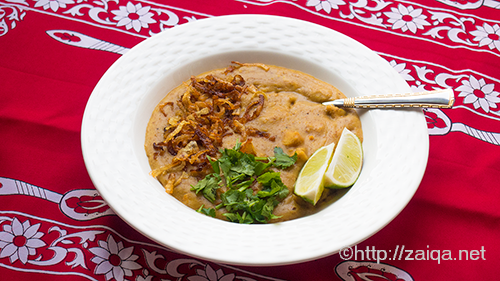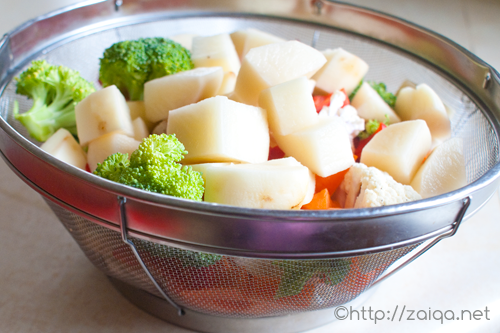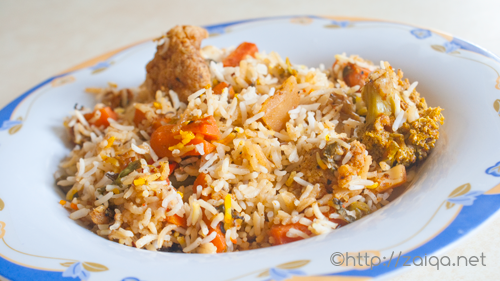Haleem is meat delicacy, especially enjoyed during the month of Ramadan in India and Pakistan. In Hyderabad, one can see all restaurants begin to sell Haleem as soon as Ramadan commences. Tiny Haleem stalls pop up at every nook and corner, and people of all faiths enjoy it. It is the city’s most induldent dishes. Haleem is not as easily available the rest of the year in restaurants in India.

Haleem is originally an Arabic dish, brought to Hyderabad by the immigrants of Yemen, Iran and Afghanistan. It has all the nutrients a fasting body requires at the end of the day.
Home cooked Haleem is the best. So today I am sharing with you all my simple recipe for Chicken Haleem. I have posted two versions of Haleem earlier on my blog. You can try them all.
Hyderabadi Chicken Haleem – Harees
Ingredients:
Serves – 6-8Boneless Chicken Breast – 2 (if large chicken); 3 (if small chicken) – cut into cubes
Marinade:
Ginger-garlic paste – 1 tbsp
Red chilli powder – 1 tsp
Turmeric powder – 1/4 tsp
Salt – 1 tsp
Haleem:
Chana dal – 100 gms
Broken wheat – 250 gms
For Qorma:
White poppy seeds/Khuskhus – 1 tsp
Chopped almonds and cashewnuts – 1 tbsp each
Canola oil – to deep fry
Onions – 3, large, finely sliced
Cloves – 2
Cardamom – 2
Cinnamon stick – one 2″ stick
Dry roasted Cumin seed powder – 1/2 tsp
Green chillies – 4, each broken into two
Yogurt – 1 cup, lightly whisked
Red chilli powder – 2 tsp
Salt – 2 tsp
Black pepper powder – 1/4 tsp
Garam masala powder – 1/2 tsp
Cardamom seed powder – 1/4 tsp
Lemon juice – 1/4 cup/60 ml/4 tbsp
For Garnish
finely chopped Cilantro, and Mint leaves
Crisply fried onions
Lemon juice
Ghee
Fried cashew nuts
sliced/chopped Green chillies

Method:
1. Soak chana dal and broken wheat for 30 minutes in fresh cool water.
2. In a mixing bowl, add the cubed chicken breast, ginger-garlic paste, 1 tsp red chilli powder, turmeric powder and 1 tsp salt. Mix well and let marinate to 1-2 hours. In a frying pan at medium high heat, pour 1 tbsp of oil add the marinated chicken and cook while turning the chicken pieces until done. Remove from heat and keep aside to cool.
3. Drain the soaking dal and the broken wheat and transfer them to a non-stick saucepan. Pour in 4 cups of fresh cool water and let cook while stirring frequently until the mixture is soft. This might take 1-3 hours. You can also pressure cook if you would like to save time, but I like to slow cook it. Add more water if needed to cook. Transfer to a bowl.
3. Meanwhile, shred the cooked chicken and keep aside in a bowl.
4. Soak cashewnuts and almonds in 1/2 cup warm water for 15 minutes. Grind them into a smooth puree.
5. In a food processor or a blender, add the cooked dal and the cooked broken wheat and process until well blended.
6. In a deep frying pan at medium high heat, pour oil to deep fry and as soon as it warms up, add the sliced onion and fry it stirring constantly until evenly golden brown in color. Using a slotted spoon transfer half of the fried onions onto a platter, scatter so that they cool and crisp up in a while, use these fried onions for garnish later on.
7. In a large non-stick saucepan, add 4 tbsp oil, lower the heat and add cloves, cinnamon stick, cardamom, green chillies and cumin seed powder. Stir fry for 10-20 secs. Add the yogurt and cook until separates. Add the pureed nuts mixture and mix well. Add red chilli powder, black pepper powder and salt. Half cover and cook stirring occasionally until it leaves oil. Add the blended wheat+dal mixture and the shredded chicken meat and mix. Pour in 2 cups water, and add garam masala powder and cardamom powder. Mix well. Cover and let cook on medium heat, stirring occasionally for 10-20 minutes. Remove from heat when the desired consistency of a thick porridge is achieved. Ladle in serving plates, garnish and serve warm.
Luv,
Mona






